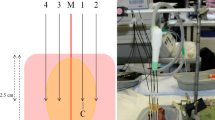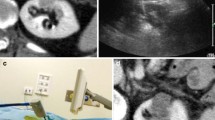Abstract
Purpose
This study was designed to analyze the effect of two different ablation modes (“temperature control” and “power control”) of a microwave system on procedural outcome in porcine kidneys in vivo.
Methods
A commercially available microwave system (Avecure Microwave Generator; MedWaves, San Diego, CA) was used. The system offers the possibility to ablate with two different ablation modes: temperature control and power control. Thirty-two microwave ablations were performed in 16 kidneys of 8 pigs. In each animal, one kidney was ablated twice by applying temperature control (ablation duration set point at 60 s, ablation temperature set point at 96°C, automatic power set point; group I). The other kidney was ablated twice by applying power control (ablation duration set point at 60 s, ablation temperature set point at 96°C, ablation power set point at 24 W; group II). Procedural outcome was analyzed: (1) technical success (e.g., system failures, duration of the ablation cycle), and (2) ablation geometry (e.g., long axis diameter, short axis diameter, and circularity).
Results
System failures occurred in 0% in group I and 13% in group II. Duration of the ablation cycle was 60 ± 0 s in group I and 102 ± 21 s in group II. Long axis diameter was 20.3 ± 4.6 mm in group I and 19.8 ± 3.5 mm in group II (not significant (NS)). Short axis diameter was 10.3 ± 2 mm in group I and 10.5 ± 2.4 mm in group II (NS). Circularity was 0.5 ± 0.1 in group I and 0.5 ± 0.1 in group II (NS).
Conclusions
Microwave ablations performed with temperature control showed fewer system failures and were finished faster. Both ablation modes demonstrated no significant differences with respect to ablation geometry.




Similar content being viewed by others
References
Gillams A (2009) Tumour ablation: current role in the kidney, lung and bone. Cancer Imaging 9 Spec No A:S68–S70
Janzen NK, Perry KT, Han KR et al (2005) The effects of intentional cryoablation and radio frequency ablation of renal tissue involving the collecting system in a porcine model. J Urol 173:1368–1374
Matin SF, Ahrar K (2008) Nephron-sparing probe ablative therapy: long-term outcomes. Curr Opin Urol 18:150–156
Mertyna P, Goldberg W, Yang W, Goldberg SN (2009) Thermal ablation a comparison of thermal dose required for radiofrequency-, microwave-, and laser-induced coagulation in an ex vivo bovine liver model. Acad Radiol 16:1539–1548
Brace CL (2009) Microwave ablation technology: what every user should know. Curr Probl Diagn Radiol 38:61–67
Simon CJ, Dupuy DE, Mayo-Smith WW (2005) Microwave ablation: principles and applications. Radiographics 25(Suppl 1):S69–S83
Laeseke PF, Lee FT Jr, Sampson LA, van der Weide DW, Brace CL (2009) Microwave ablation versus radiofrequency ablation in the kidney: high-power triaxial antennas create larger ablation zones than similarly sized internally cooled electrodes. J Vasc Interv Radiol 20:1224–1229
Lubner MG, Brace CL, Hinshaw JL, Lee FT Jr (2010) Microwave tumor ablation: mechanism of action, clinical results, and devices. J Vasc Interv Radiol 21:S192–S203
Jiao D, Qian L, Zhang Y et al (2010) Microwave ablation treatment of liver cancer with 2, 450-MHz cooled-shaft antenna: an experimental and clinical study. J Cancer Res Clin Oncol 136:1507–1516
Bai J, Hu Z, Guan W et al (2010) Initial experience with retroperitoneoscopic microwave ablation of clinical T(1a) renal tumors. J Endourol 24:2017–2022
Clark PE, Woodruff RD, Zagoria RJ, Hall MC (2007) Microwave ablation of renal parenchymal tumors before nephrectomy: phase I study. AJR Am J Roentgenol 188:1212–1214
Martin RC, Scoggins CR, McMasters KM (2010) Safety and efficacy of microwave ablation of hepatic tumors: a prospective review of a 5-year experience. Ann Surg Oncol 17:171–178
Crowley JD, Shelton J, Iverson AJ, Burton MP, Dalrymple NC, Bishoff JT (2001) Laparoscopic and computed tomography-guided percutaneous radiofrequency ablation of renal tissue: acute and chronic effects in an animal model. Urology 57:976–980
Goldberg SN, Gazelle GS, Compton CC, Mueller PR, Tanabe KK (2000) Treatment of intrahepatic malignancy with radiofrequency ablation: radiologic-pathologic correlation. Cancer 88:2452–2463
Burdio F, Navarro A, Sousa R et al (2006) Evolving technology in bipolar perfused radiofrequency ablation: assessment of efficacy, predictability and safety in a pig liver model. Eur Radiol 16:1826–1834
Chung H, Kudo M, Minami Y, Kawasaki T (2007) Radiofrequency ablation combined with reduction of hepatic blood flow: effect of Lipiodol on coagulation diameter and ablation time in normal pig liver. Hepatogastroenterology 54:701–704
Marcovich R, Aldana JP, Morgenstern N, Jacobson AI, Smith AD, Lee BR (2003) Optimal lesion assessment following acute radio frequency ablation of porcine kidney: cellular viability or histopathology? J Urol 170:1370–1374
Prakash P (2010) Theoretical modeling for hepatic microwave ablation. Open Biomed Eng J 4:27–38
Awad MM, Devgan L, Kamel IR, Torbensen M, Choti MA (2007) Microwave ablation in a hepatic porcine model: correlation of CT and histopathologic findings. HPB (Oxford) 9:357–362
Hsu TH, Fidler ME, Gill IS (2000) Radiofrequency ablation of the kidney: acute and chronic histology in porcine model. Urology 56:872–875
Nakada SY, Jerde TJ, Warner TF et al (2003) Bipolar radiofrequency ablation of the kidney: comparison with monopolar radiofrequency ablation. J Endourol 17:927–933
Denys AL, De Baere T, Kuoch V et al (2003) Radio-frequency tissue ablation of the liver: in vivo and ex vivo experiments with four different systems. Eur Radiol 13:2346–2352
Moore C, Salas N, Zaias J, Shields J, Bird V, Leveillee R (2010) Effects of microwave ablation of the kidney. J Endourol 24:439–444
Hope WW, Schmelzer TM, Newcomb WL et al (2009) Guidelines for power and time variables for microwave ablation in an in vivo porcine kidney. J Surg Res 153:263–267
Zhang D, Dong B, Wang Y et al (2009) Percutaneous microwave ablation or nephrectomy for VX-2 carcinoma in rabbit kidney. J Urol 182:1588–1593
Conflict of interest
The authors declare that they have no conflict of interest.
Author information
Authors and Affiliations
Corresponding author
Rights and permissions
About this article
Cite this article
Sommer, C.M., Arnegger, F., Koch, V. et al. Microwave Ablation of Porcine Kidneys in vivo: Effect of two Different Ablation Modes (“Temperature Control” and “Power Control”) on Procedural Outcome. Cardiovasc Intervent Radiol 35, 653–660 (2012). https://doi.org/10.1007/s00270-011-0171-5
Received:
Accepted:
Published:
Issue Date:
DOI: https://doi.org/10.1007/s00270-011-0171-5




